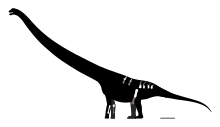|
Jingiella
Jingiella is an extinct genus of mamenchisaurid sauropod dinosaur from the Late Jurassic Dongxing Formation of Guangxi, China. The genus contains a single species, J. dongxingensis, known from vertebrae and limb bones. The original description of Jingiella referred to it using the name "Jingia" which was preoccupied by a moth genus named in 1983, and an amendment was published shortly thereafter, establishing Jingiella as the new replacement name. Discovery and naming The Jingiella holotype specimen, DXJL2021001, was discovered in sediments of the Dongxing Formation in Dongxing town of Dongxing city in Guangxi Zhuang Autonomous Region, South China. The specimen consists of fragmentary remains, including partial dorsal, sacral, and caudal vertebrae, part of both ulnae, and the proximal end of the right femur. The bones were restored by the Chongzhou Tianyan Museum.[1] In 2024, Ren et al. proposed "Jingia" dongxingensis as a new genus and species of mamenchisaurid sauropod based on these fossil remains. The generic name, Jingia, was intended to honor Chinese people of the Jing Nationality who emigrated from Vietnam. The specific name, dongxingensis, references the type locality in Dongxing City, where many Jing people live.[1] The genus name "Jingia" was preoccupied by a moth described in 1983.[2] As such, a replacement name was needed. Ren et al. published an addendum shortly after the original description, amending the error and establishing Jingiella as the new generic name.[3] Classification In their phylogenetic analyses, Ren et al. (2024) recovered Jingiella as a late-diverging member of Mamenchisauridae, as the sister taxon to the clade containing Mamenchisaurus youngi, Chuanjiesaurus, and Wamweracaudia. Their results are shown in the cladogram below:[1] References
|
||||||||||||||||||||||||||||||||












